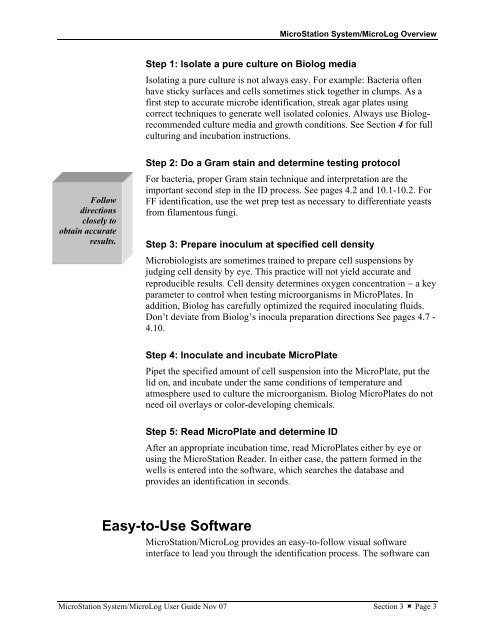MicroStation System, MicroLog Version 4.2 - DTU Systems Biology ...
MicroStation System, MicroLog Version 4.2 - DTU Systems Biology ...
MicroStation System, MicroLog Version 4.2 - DTU Systems Biology ...
Create successful ePaper yourself
Turn your PDF publications into a flip-book with our unique Google optimized e-Paper software.
Follow<br />
directions<br />
closely to<br />
obtain accurate<br />
results.<br />
Step 1: Isolate a pure culture on Biolog media<br />
<strong>MicroStation</strong> <strong>System</strong>/<strong>MicroLog</strong> Overview<br />
Isolating a pure culture is not always easy. For example: Bacteria often<br />
have sticky surfaces and cells sometimes stick together in clumps. As a<br />
first step to accurate microbe identification, streak agar plates using<br />
correct techniques to generate well isolated colonies. Always use Biologrecommended<br />
culture media and growth conditions. See Section 4 for full<br />
culturing and incubation instructions.<br />
Step 2: Do a Gram stain and determine testing protocol<br />
For bacteria, proper Gram stain technique and interpretation are the<br />
important second step in the ID process. See pages <strong>4.2</strong> and 10.1-10.2. For<br />
FF identification, use the wet prep test as necessary to differentiate yeasts<br />
from filamentous fungi.<br />
Step 3: Prepare inoculum at specified cell density<br />
Microbiologists are sometimes trained to prepare cell suspensions by<br />
judging cell density by eye. This practice will not yield accurate and<br />
reproducible results. Cell density determines oxygen concentration − a key<br />
parameter to control when testing microorganisms in MicroPlates. In<br />
addition, Biolog has carefully optimized the required inoculating fluids.<br />
Don’t deviate from Biolog’s inocula preparation directions See pages 4.7 -<br />
4.10.<br />
Step 4: Inoculate and incubate MicroPlate<br />
Pipet the specified amount of cell suspension into the MicroPlate, put the<br />
lid on, and incubate under the same conditions of temperature and<br />
atmosphere used to culture the microorganism. Biolog MicroPlates do not<br />
need oil overlays or color-developing chemicals.<br />
Step 5: Read MicroPlate and determine ID<br />
After an appropriate incubation time, read MicroPlates either by eye or<br />
using the <strong>MicroStation</strong> Reader. In either case, the pattern formed in the<br />
wells is entered into the software, which searches the database and<br />
provides an identification in seconds.<br />
Easy-to-Use Software<br />
<strong>MicroStation</strong>/<strong>MicroLog</strong> provides an easy-to-follow visual software<br />
interface to lead you through the identification process. The software can<br />
<strong>MicroStation</strong> <strong>System</strong>/<strong>MicroLog</strong> User Guide Nov 07 Section 3 � Page 3


